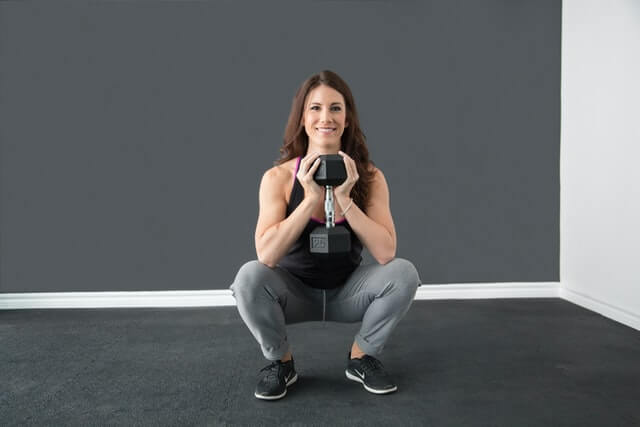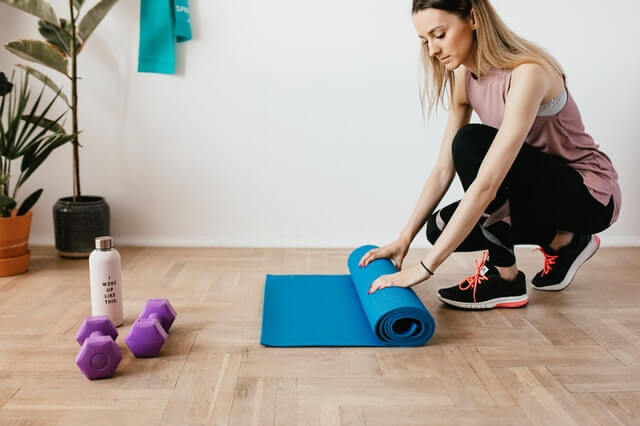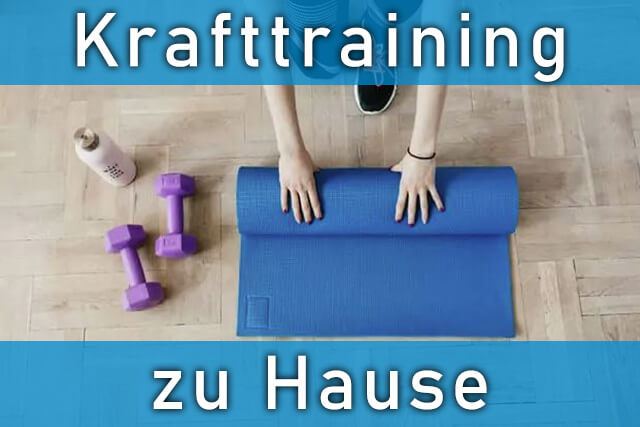Not only in the wake of the pandemic situation, many women are looking for strength training exercises to do at home. Lack of time often plays a role when a woman decides not to go to the gym. Almost all of us have probably tried some isometric exercises at home and perhaps even worked with the elastic band.
Most of us are also familiar with push-ups as simple but effective exercises. What can strength training achieve within the four walls of your home ? Are there similar training effects to those in the gym? Can you do your shoulder exercises and leg training at home? Does training without a gym make sense and which exercises are recommended?
We have compiled information about strength training for women at home .

Strength training at home: why is it effective?
For a long time, exercises to build strength were reserved for men, who often developed a lot of ambition when it came to building muscle. The proverbial 10,000 steps was considered a benchmark for sufficient physical activity for the fitness of less ambitious people who simply wanted to stay mobile.
However, recent scientific findings show that brisk walking and counting steps are not enough to keep yourself physically fit. Muscle training must not be neglected if we want to remain fit, flexible and independent, especially as we age. Women benefit from including targeted shoulder exercises and full-body strength training in their training routine.
Muscle loss, weight and bone strength
After all, muscle breakdown begins as early as the age of 30, which is responsible for many symptoms of deterioration in middle and advanced age. The bones also want further training in order to remain strong.
Last but not least, targeted exercises such as shoulder exercises against resistance also lead to an increase in our basal metabolic rate by building muscles . A higher basal metabolic rate means higher energy consumption and reduces the risk of becoming overweight. Reducing excess weight and maintaining weight are generally difficult to imagine after a certain age without strength training exercises.
Women benefit from building muscle at home and in the gym on several levels. That's why even women who shy away from going to the gym can get excited about strength training at home .
Exercises for women are currently experiencing a renaissance. They are often not as easy to integrate into everyday life as a few thousand steps, which in some professional groups are completed almost casually. Does strength training for women at home also create the basis for maintaining and even building muscle? What do women have to consider?
How is strength training defined?
Strength training is generally physical training aimed at building muscle mass and/or increasing maximum strength. Unlike endurance training, it's about visible physical changes in the medium term. Strengthening the muscles is achieved through adaptation processes in the body. A high level of stress leads to minimal damage to the muscles.
As part of the repair process, the muscle becomes stronger in order to be prepared for further stress in the future. Sore muscles can indicate subtle injuries. It's not just different exercises that build muscle. The body must also have the appropriate building materials, especially protein, in order to increase muscle mass.
The exercises are determined not only by the “ if ” but also by the “ how ”. Depending on their performance level, women should train according to a training plan that is continually adapted to their progress.

Strength training at home with and without equipment
The exercises can be performed with or without equipment. Without equipment, the body works under the strain of its own weight. Whether with or without equipment, classic strength training exercises consist of pulling and pushing movements. For example, a pulling movement occurs when a woman lifts a dumbbell with her right arm while training at home.
Isometric exercises can also help build muscle and strength. These are static exercises in which a muscle is held under tension for a while without any pushing or pulling movement. Strength training at home without equipment is particularly easy and effective. However, many of us have doubts about whether these fitness exercises are of any use.
As we will see, it all depends on the resistance and intensity of the exercises. You can make training at home easy if you don't need any equipment or supplies. She cannot forego the intensity and consistency in training. This applies to all areas of the body such as shoulder exercises and isometric exercises.
In addition , strength training without equipment is particularly dependent on a training plan and a concept. Professional advice from a personal trainer can be very helpful here.
What's the point of strength training at home without equipment?
For strength training, women can work at home with simple equipment such as dumbbells or tension bands. You can also use everyday objects like filled water bottles as weights. Many exercises without equipment are very effective, such as push-ups, which are now also known as planks in their various variations.
A recent study from 2020 shows that training without equipment against your own body resistance can be just as effective as training with equipment and dumbbells. Even without equipment, you can achieve strength and muscle growth at home if you choose the right exercises. Strength training without equipment is particularly advantageous if you want to start immediately and don't have your own equipment.
In addition, you can carry out the training even in the tightest of spaces and you don't waste space setting up or storing equipment. However, a simple tool like an elastic band doesn't take up much space. The exercises can also be easily combined with and without equipment.
Overall , when strength training at home, you benefit from variations and variety in your training. The same training stimulus often doesn't get you anywhere. That's why it can be helpful if you consider different training options when strength training at home . Isometric exercises alternate with pulling and pushing exercises. Shoulder exercises with leg exercises and training for the whole body.

To stretch or not to stretch?
The topic of stretching after strength training has been controversial for some time. Until 15 years ago it was said that stretching was always done after strength training , but some experts question the benefits of stretching exercises. What could be the point of stretching after training?
Targeted strength training puts the muscle under tension. If this tension lasts for a long time, it can limit mobility. Stretching after strength training and endurance sports reduces tension and muscle tone again. Above all, stretching after strength training is aimed at increasing mobility. For a long time, athletes and scientists also assumed that stretching could reduce muscle soreness. This assumption has today turned out to be wrong.
In some cases there is even talk of reduced muscle growth through stretching. However, most sports therapists and personal trainers also recommend short stretching sessions for strength training at home . Stretching after strength training should at least reduce the risk of strains and, above all, maintain general mobility. Not all stretches are the same. Alternate short static and dynamic stretching exercises.

Training in special life situations such as pregnancy
Many women have this question: Can I do strength training during pregnancy ? Sports experts assume that women in particular who have already trained their strength and muscles with or without weights can continue strength training during pregnancy . Not all exercises are suitable and overloading should be avoided.
Isometric exercises are also not suitable for every form of pregnancy. It is advisable to consult a specialized personal trainer, midwife and gynecologist to coordinate targeted strength training during pregnancy. Training in the studio may be more recommended here.
But it depends on the individual case. Approach isometric exercises as strength training during pregnancy very carefully and seek advice beforehand. Also find out which strength training without equipment is suitable for you in this particular phase of your life.
What applies to strength training in old age?
As far as age is concerned, starting strength training exercises for women is possible at any time without any problems. Isometric exercises can also be suitable. A personal trainer and a sports doctor are also required as advisors to avoid overload.
Even when training at home, you should discuss a training plan with an expert beforehand. Many variations of strength training exercises are possible, even for older women. Strength training for women at home offers a variety of options for shoulder exercises, strengthening the back, stomach and legs.
Shoulder exercises in particular can be of great importance because the muscles in the back area compensate for the decreasing stability of the intervertebral discs due to age. Even small isometric exercises, regular shoulder exercises and exercises to strengthen the entire back can have a very positive effect.
Isometric exercises have the advantage that they are performed statically and are therefore easy for older women to do. That's why women often put isometric exercises and shoulder exercises together with training the abdominal muscles at the center of their exercise routine. Strength training without equipment is also suitable for older people.
What role does nutrition play?
When training without equipment or with equipment, make sure you have a sufficient supply of amino acids and proteins , the smallest building blocks of protein. The protein requirement can be increased, especially in special life situations. This applies to strength training during pregnancy as well as building muscle in old age . Additional dietary supplements with protein and amino acids can be useful.
Strength training at home: suggestions & exercises
Here are some strength training suggestions that women can do at home . The first thing is strength training without equipment .
This article is about isometric exercises and especially shoulder exercises that also have a therapeutic effect.
You can see suggestions for strength training during pregnancy here :
Have a personal trainer instruct you on post-workout stretching. When it comes to stretching exercises, it's important that you do them at the right time and intensity. Stretching can be quite challenging.
Strength training exercises can not only be carried out effectively in the gym. Strength training at home will keep you fit and happy if you know how to do it. Strength training at home should be planned in the same way as training sessions in a studio.




